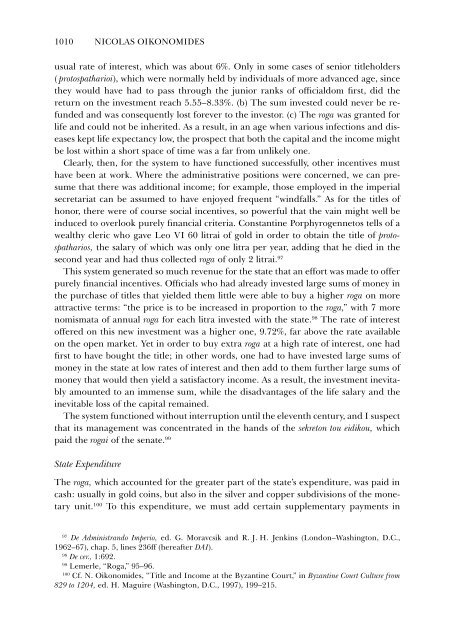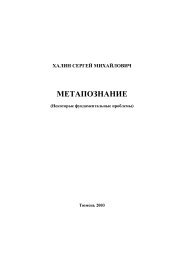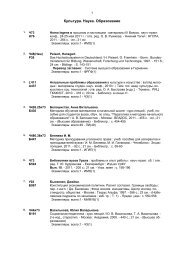The Economic History of Byzantium - Dumbarton Oaks
The Economic History of Byzantium - Dumbarton Oaks
The Economic History of Byzantium - Dumbarton Oaks
Create successful ePaper yourself
Turn your PDF publications into a flip-book with our unique Google optimized e-Paper software.
1010 NICOLAS OIKONOMIDES<br />
usual rate <strong>of</strong> interest, which was about 6%. Only in some cases <strong>of</strong> senior titleholders<br />
( protospatharioi), which were normally held by individuals <strong>of</strong> more advanced age, since<br />
they would have had to pass through the junior ranks <strong>of</strong> <strong>of</strong>ficialdom first, did the<br />
return on the investment reach 5.55–8.33%. (b) <strong>The</strong> sum invested could never be refunded<br />
and was consequently lost forever to the investor. (c) <strong>The</strong> roga was granted for<br />
life and could not be inherited. As a result, in an age when various infections and diseases<br />
kept life expectancy low, the prospect that both the capital and the income might<br />
be lost within a short space <strong>of</strong> time was a far from unlikely one.<br />
Clearly, then, for the system to have functioned successfully, other incentives must<br />
have been at work. Where the administrative positions were concerned, we can presume<br />
that there was additional income; for example, those employed in the imperial<br />
secretariat can be assumed to have enjoyed frequent “windfalls.” As for the titles <strong>of</strong><br />
honor, there were <strong>of</strong> course social incentives, so powerful that the vain might well be<br />
induced to overlook purely financial criteria. Constantine Porphyrogennetos tells <strong>of</strong> a<br />
wealthy cleric who gave Leo VI 60 litrai <strong>of</strong> gold in order to obtain the title <strong>of</strong> protospatharios,<br />
the salary <strong>of</strong> which was only one litra per year, adding that he died in the<br />
second year and had thus collected roga <strong>of</strong> only 2 litrai. 97<br />
This system generated so much revenue for the state that an effort was made to <strong>of</strong>fer<br />
purely financial incentives. Officials who had already invested large sums <strong>of</strong> money in<br />
the purchase <strong>of</strong> titles that yielded them little were able to buy a higher roga on more<br />
attractive terms: “the price is to be increased in proportion to the roga,” with 7 more<br />
nomismata <strong>of</strong> annual roga for each litra invested with the state. 98 <strong>The</strong> rate <strong>of</strong> interest<br />
<strong>of</strong>fered on this new investment was a higher one, 9.72%, far above the rate available<br />
on the open market. Yet in order to buy extra roga at a high rate <strong>of</strong> interest, one had<br />
first to have bought the title; in other words, one had to have invested large sums <strong>of</strong><br />
money in the state at low rates <strong>of</strong> interest and then add to them further large sums <strong>of</strong><br />
money that would then yield a satisfactory income. As a result, the investment inevitably<br />
amounted to an immense sum, while the disadvantages <strong>of</strong> the life salary and the<br />
inevitable loss <strong>of</strong> the capital remained.<br />
<strong>The</strong> system functioned without interruption until the eleventh century, and I suspect<br />
that its management was concentrated in the hands <strong>of</strong> the sekreton tou eidikou, which<br />
paid the rogai <strong>of</strong> the senate. 99<br />
State Expenditure<br />
<strong>The</strong> roga, which accounted for the greater part <strong>of</strong> the state’s expenditure, was paid in<br />
cash: usually in gold coins, but also in the silver and copper subdivisions <strong>of</strong> the monetary<br />
unit. 100 To this expenditure, we must add certain supplementary payments in<br />
97 De Administrando Imperio, ed. G. Moravcsik and R. J. H. Jenkins (London–Washington, D.C.,<br />
1962–67), chap. 5, lines 236ff (hereafter DAI).<br />
98 De cer., 1:692.<br />
99 Lemerle, “Roga,” 95–96.<br />
100 Cf. N. Oikonomides, “Title and Income at the Byzantine Court,” in Byzantine Court Culture from<br />
829 to 1204, ed. H. Maguire (Washington, D.C., 1997), 199–215.








